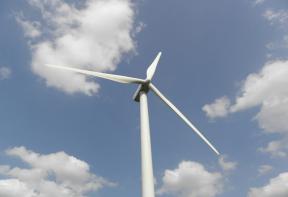Exploring your options for solar and wind power
Research renewable energy solutions for your home
It looks like a gigantic piece of art,” remarked my Uncle Robert as we drove past the large wind turbine in Toronto. He’s right. Like a piece of art, the turbine is one of a kind–the first large-scale wind turbine in an urban downtown setting in North America. Standing 30 storeys tall, it generates an average of 1,400 megawatt hours of power per year, equivalent to the yearly electricity needs of about 250 homes. It has displaced 815 tonnes of carbon dioxide emissions and generated more than two billion kilowatt hours since 2002–producing zero waste and zero emissions. Even an artist like Michelangelo couldn’t do that.
Visible from across the city, the wind turbine is a daily reminder of renewable energy’s potential and the ever-encroaching energy crisis we face as we burn through remnant fossil fuels. The average Canadian household consumes 700 to 1,500 kilowatts of power a month, and we’re the worst per-capita abusers of energy consumption among G-8 countries, alongside the U.S. “There’s a perception that Canada is an energy superpower,” says Rob McMonagle of the Canadian Solar Industries Association. McMonagle has been working with renewable energy since the 1970s, back when Canada was a world leader in design and application. “We’ve always taken our energy for granted and never focused on replacement sources. Now people are beginning to realize we need to take renewable energy seriously.”
OK, so we know our energy predicament is serious. We’ve found ways to make our homes tighter with energy-efficient furnaces, windows and doors–but what’s the next step? Should I erect a gigantic wind turbine on my front lawn? What about solar power or microhydro systems that generate power from water? What’s realistic?
Exploring your options
First, the basics. Wind turbines generate power when the blades turn, which cause interior magnets to move and create power. So, the faster the wind, the higher the output.
Like sailboats, wind turbines rely on steady wind and are most effective where there are no obstructions, such as in a farmer’s field free of trees and buildings. “You need a steady wind flow for a turbine to be effective, and you probably have to be on a high piece of land,” says Ontario’s Hydro One spokesman Al Manchee. So, if you live in a subdivision or city, you can rule out this option.
While large turbines might not be suitable, smaller wind generators are still great for running electronics and lights at cottages, usually because you’re situated beside a lake or river with faster prevailing winds. Canadian Tire sells smaller wind generators (from $700) that are great for recharging boat batteries and operating other remote structures, such as a beachside sauna.
Another option: installing a microhydro system, which generates electricity from falling water–not to be confused with large-scale hydro dams. Here, electricity is produced from the energy in water that’s flowing from a high level down to a lower level; the bigger the drop, the more power to the turbine and the more electricity produced. If you have a small waterfall in your backyard, a microhydro system (costing $2,000 to $3,000 from Energy Alternatives in Victoria) might be a smart investment. These systems work well in conjunction with a solar system: solar systems generate more energy during the summer months because of the longer days; microhydro systems work best in winter, when water flows fastest.
Luckily, those of us without tumbling waterfalls and vast, windy fields have a third option: solar panels. For regular people, “solar power is the most widely available renewable energy source,” says McMonagle. “Unlike microhydro or wind systems, it’s fairly easy to install a small system on your rooftop, no matter where you live.”
Jump to a section
- Page 1 : Exploring your options
- Page 2 : Solar basics
- Page 3 : Benefit beyond the bottom line
To leave a comment, please log in












No comments